Dating Oceanic Subduction in the Jurassic Bangong–Nujiang Oceanic Arc: A Zircon U–Pb Age and Lu–Hf Isotopes and Al-in-Hornblende Barometry Study of the Lameila Pluton in Western Tibet, China
Abstract
1. Introduction
2. Geological Background
2.1. Tectonic Evolution of the Bangong–Nujiang Ocean
2.2. Geology of the Study Area
3. Samples and Analytical Methods
3.1. Sampling and Petrography
3.2. In-Situ LA-ICP-MS U–Pb Dating and Trace Elements of Zircon
3.3. In-Situ LA-MC-ICP-MS Lu–Hf Isotopes of Zircon
3.4. EPMA Amphibole Chemistry
4. Results
4.1. Zircon U–Pb Geochronology and Trace Elements
4.2. In-Situ Zircon Lu–Hf Isotopes
4.3. Amphibole Chemistry and Stoichiometry
5. Discussion
5.1. Key Control Factors on the Variation of Amphibole Compositions
5.2. Al-in-Hornblende Barometer and Depth of the Lameila Pluton Emplacement
5.3. Mechanism for the Crustal Thickening of the Jurassic Oceanic Arcin the BNO
5.4. Oceanic Arc Development and Two Contrasting Sources for Magmatism
6. Conclusions
Author Contributions
Funding
Acknowledgments
Conflicts of Interest
References
- Fielding, E.; Isacks, B.; Barazangi, M.; Duncan, C. How flat is Tibet? Geology 1994, 22, 163–167. [Google Scholar] [CrossRef]
- Zhang, Z.; Deng, Y.; Teng, J.; Wang, C.; Gao, R.; Chen, Y.; Fan, W. An overview of the crustal structure of the Tibetan plateau after 35 years of deep seismic soundings. J. Asian Earth Sci. 2011, 40, 977–989. [Google Scholar] [CrossRef]
- Kapp, P.; DeCelles, P.G. Mesozoic–Cenozoic geological evolution of the Himalayan-Tibetan orogen and working tectonic hypotheses. Am. J. Sci. 2019, 319, 159–254. [Google Scholar] [CrossRef]
- Zhu, D.-C.; Zhao, Z.-D.; Niu, Y.; Dilek, Y.; Hou, Z.-Q.; Mo, X.-X. The origin and pre-Cenozoic evolution of the Tibetan Plateau. Gondwana Res. 2013, 23, 1429–1454. [Google Scholar] [CrossRef]
- Yin, A.; Harrison, T.M. Geologic evolution of the Himalayan-Tibetan Orogen. Annu. Rev. Earth Plant Sci. 2000, 28, 211–280. [Google Scholar] [CrossRef]
- Li, S.; Yin, C.; Guilmette, C.; Ding, L.; Zhang, J. Birth and demise of the Bangong–Nujiang Tethyan Ocean: A review from the Gerze area of central Tibet. Earth Sci. Rev. 2019, 198, 102907. [Google Scholar] [CrossRef]
- Zhu, D.-C.; Li, S.-M.; Cawood, P.A.; Wang, Q.; Zhao, Z.-D.; Liu, S.-A.; Wang, L.-Q. Assembly of the Lhasa and Qiangtang terranes in central Tibet by divergent double subduction. Lithos 2016, 245, 7–17. [Google Scholar] [CrossRef]
- Kapp, P.; Murphy, M.A.; Yin, A.; Harrison, T.M.; Ding, L.; Guo, J.H. Mesozoic and Cenozoic tectonic evolution of the Shiquanhe area of western Tibet. Tectonics 2003, 22, 1–24. [Google Scholar] [CrossRef]
- Fan, J.-J.; Li, C.; Liu, J.-H.; Wang, M.; Liu, Y.-M.; Xie, C.-M. The Middle Triassic evolution of the Bangong–Nujiang Tethyan Ocean: Evidence from analyses of OIB-type basalts and OIB-derived phonolites in northern Tibet. Int. J. Earth Sci. 2018, 107, 1755–1775. [Google Scholar] [CrossRef]
- Wang, B.-D.; Wang, L.-Q.; Chung, S.-L.; Chen, J.-L.; Yin, F.-G.; Liu, H.; Li, X.-B.; Chen, L.-K. Evolution of the Bangong–Nujiang Tethyan ocean: Insights from the geochronology and geochemistry of mafic rocks within ophiolites. Lithos 2016, 245, 18–33. [Google Scholar] [CrossRef]
- Zhang, K.-J.; Xia, B.; Zhang, Y.-X.; Liu, W.-L.; Zeng, L.; Li, J.-F.; Xu, L.-F. Central Tibetan Meso-Tethyan oceanic plateau. Lithos 2014, 210–211, 278–288. [Google Scholar] [CrossRef]
- Tian, X.; Wu, Q.; Zhang, Z.; Teng, J.; Zeng, R. Joint imaging by teleseismic converted and multiple waves and its application in the INDEPTH-III passive seismic array. Geophys. Res. Lett. 2005, 32. [Google Scholar] [CrossRef]
- Li, X.-K.; Chen, J.; Wang, R.-C.; Li, C. Temporal and spatial variations of Late Mesozoic granitoids in the SW Qiangtang, Tibet: Implications for crustal architecture, Meso-Tethyan evolution and regional mineralization. Earth Sci. Rev. 2018, 185, 374–396. [Google Scholar] [CrossRef]
- Hao, L.-L.; Wang, Q.; Zhang, C.; Ou, Q.; Yang, J.-H.; Dan, W.; Jiang, Z.-Q. Oceanic plateau subduction during closure of the Bangong–Nujiang Tethyan Ocean: Insights from central Tibetan volcanic rocks. GSA Bull. 2018, 131, 864–880. [Google Scholar] [CrossRef]
- Liu, D.; Shi, R.; Ding, L.; Huang, Q.; Zhang, X.; Yue, Y.; Zhang, L. Zircon U–Pb age and Hf isotopic compositions of Mesozoic granitoids in southern Qiangtang, Tibet: Implications for the subduction of the Bangong–Nujiang Tethyan Ocean. Gondwana Res. 2017, 41, 157–172. [Google Scholar] [CrossRef]
- Li, J.-X.; Qin, K.-Z.; Li, G.-M.; Richards, J.P.; Zhao, J.-X.; Cao, M.-J. Geochronology, geochemistry, and zircon Hf isotopic compositions of Mesozoic intermediate–felsic intrusions in central Tibet: Petrogenetic and tectonic implications. Lithos 2014, 198–199, 77–91. [Google Scholar] [CrossRef]
- Zhang, Q.; Yang, R.-Y. The geochemical characteristics of intrusion of boninitic series from Dingqing, Xizang. Acta Petrol. Sin. 1987, 2, 64–74. [Google Scholar]
- Shi, R.D.; Yang, J.S.; Xu, Z.Q.; Qi, X.X. Discovery of the boninite series volcanic rocks in the Bangong Lake ophiolite mélange, western Tibet, and its tectonic implications. Chin. Sci. Bull. 2004, 49, 1272–1278. [Google Scholar] [CrossRef]
- Liu, W.-L.; Huang, Q.-T.; Gu, M.; Zhong, Y.; Zhou, R.; Gu, X.-D.; Zheng, H.; Liu, J.-N.; Lu, X.-X.; Xia, B. Origin and tectonic implications of the Shiquanhe high-Mg andesite, western Bangong suture, Tibet. Gondwana Res. 2018, 60, 1–14. [Google Scholar] [CrossRef]
- Zeng, Y.-C.; Chen, J.-L.; Xu, J.-F.; Wang, B.-D.; Huang, F. Sediment melting during subduction initiation: Geochronological and geochemical evidence from the Darutso high-Mg andesites within ophiolite melange, central Tibet. Geochem. Geophys. Geosys. 2016, 17, 4859–4877. [Google Scholar] [CrossRef]
- Pan, G.; Wang, L.; Li, R.; Yuan, S.; Ji, W.; Yin, F.; Zhang, W.; Wang, B. Tectonic evolution of the Qinghai–Tibet plateau. J. Asian Earth Sci. 2012, 53, 3–14. [Google Scholar] [CrossRef]
- Pan, G.T.; Ding, J.; Yao, D.S. Geological Map (1:1500,000) of Qinghai-Xizang (Tibet) Plateau and Adjacent Areas; Chengdu Cartographic Publishing House: Chengdu, China, 2004. [Google Scholar]
- Zhang, Y.-X.; Li, Z.-W.; Zhu, L.-D.; Zhang, K.-J.; Yang, W.-G.; Jin, X. Newly discovered eclogites from the Bangong Meso–Tethyan suture zone (Gaize, central Tibet, western China): Mineralogy, geochemistry, geochronology, and tectonic implications. Int. Geol. Rev. 2015, 1–14. [Google Scholar] [CrossRef]
- Zhong, Y.; Liu, W.-L.; Xia, B.; Liu, J.-N.; Guan, Y.; Yin, Z.-X.; Huang, Q.-T. Geochemistry and geochronology of the Mesozoic Lanong ophiolitic mélange, northern Tibet: Implications for petrogenesis and tectonic evolution. Lithos 2017, 292, 111–131. [Google Scholar] [CrossRef]
- Zhou, Y.; Cheng, X.; Yu, L.; Yang, X.; Su, H.; Peng, X.; Xue, Y.; Li, Y.; Ye, Y.; Zhang, J.; et al. Paleomagnetic study on the Triassic rocks from the Lhasa Terrane, Tibet, and its paleogeographic implications. J. Asian Earth Sci. 2016, 121, 108–119. [Google Scholar] [CrossRef]
- Cao, Y.; Sun, Z.; Li, H.; Pei, J.; Liu, D.; Zhang, L.; Ye, X.; Zheng, Y.; He, X.; Ge, C.; et al. New paleomagnetic results from middle Jurassic limestones of the Qiangtang Terrane, Tibet: Constraints on the evolution of the Bangong–Nujiang Ocean. Tectonics 2019, 38, 215–232. [Google Scholar] [CrossRef]
- Song, P.; Ding, L.; Li, Z.; Lippert, P.C.; Yang, T.; Zhao, X.; Fu, J.; Yue, Y. Late Triassic paleolatitude of the Qiangtang block: Implications for the closure of the Paleo-Tethys Ocean. Earth Planet Sci. Lett. 2015, 424, 69–83. [Google Scholar] [CrossRef]
- Li, J.-X.; Qin, K.-Z.; Li, G.-M.; Xiao, B.; Zhao, J.-X.; Cao, M.-J.; Chen, L. Petrogenesis of ore-bearing porphyries from the Duolong porphyry Cu–Au deposit, central Tibet: Evidence from U–Pb geochronology, petrochemistry and Sr–Nd–Hf–O isotope characteristics. Lithos 2013, 160–161, 216–227. [Google Scholar] [CrossRef]
- Zhang, K.-J.; Zhang, Y.-X.; Tang, X.-C.; Xia, B. Late Mesozoic tectonic evolution and growth of the Tibetan plateau prior to the Indo–Asian collision. Earth Sci. Rev. 2012, 114, 236–249. [Google Scholar] [CrossRef]
- Zhou, M.F.; Malpas, J.; Robinson, P.T.; Reynolds, P.H. The dynamothermal aureole of the Donqiao ophiolite (northern Tibet). Can. J. Earth Sci. 1997, 34, 59–65. [Google Scholar] [CrossRef]
- Shi, R.D. SHRIMP dating of the Bangong Lake SSZ-type ophiolite: Constraints on the closure time of ocean in the Bangong Lake–Nujiang River, northwestern Tibet. Chin. Sci. Bull. 2007, 52, 936–941. [Google Scholar] [CrossRef]
- Shi, R.D. Recognition of the Bangong Lake MOR-and SSZ-Type Ophiolites in the Northwestern Tibet Plateau and Its Tectonic Significance. Ph.D. Thesis, Institute of Geology, Chinese Academy of Geological Sciences, Beijing, China, 2005. [Google Scholar]
- Zhu, D.C.; Zhao, Z.D.; Niu, Y.L.; Mo, X.X.; Chung, S.L.; Hou, Z.Q.; Wang, L.Q.; Wu, F.Y. The Lhasa Terrane: Record of a microcontinent and its histories of drift and growth. Earth Planet Sci. Lett. 2011, 301, 241–255. [Google Scholar] [CrossRef]
- Girardeau, J.; Marcoux, J.; Allegre, C.J.; Bassoullet, J.P.; Youking, T.; Xuchang, X.; Yougong, Z.; Xibin, W. Tectonic environment and geodynamic significance of the Neo-Cimmerian Donqiao ophiolite, Bangong–Nujiang suture zone, Tibet. Nature 1984, 307, 27–31. [Google Scholar] [CrossRef]
- Matte, P.; Tapponnier, P.; Arnaud, N.; Bourjot, L.; Avouac, J.P.; Vidal, P.; Liu, Q.; Pan, Y.S.; Wang, Y. Tectonics of western Tibet, between the Tarim and the Indus. Earth Planet Sci. Lett. 1996, 142, 311–330. [Google Scholar] [CrossRef]
- Kapp, P.; DeCelles, P.G.; Gehrels, G.E.; Heizler, M.; Ding, L. Geological records of the Lhasa–Qiangtang and Indo–Asian collisions in the Nima area of central Tibet. Geol. Soc. Am. Bull. 2007, 119, 917–933. [Google Scholar] [CrossRef]
- Liu, D.-L.; Shi, R.-D.; Ding, L.; Zou, H.-B. Late Cretaceous transition from subduction to collision along the Bangong–Nujiang Tethys: New volcanic constraints from central Tibet. Lithos 2018, 296, 452–470. [Google Scholar] [CrossRef]
- Li, S.-M.; Zhu, D.-C.; Wang, Q.; Zhao, Z.-D.; Sui, Q.-L.; Liu, S.-A.; Liu, D.; Mo, X.-X. Northward subduction of Bangong–Nujiang Tethys: Insight from Late Jurassic intrusive rocks from Bangong Tso in western Tibet. Lithos 2014, 205, 284–297. [Google Scholar] [CrossRef]
- Liu, D.; Huang, Q.; Fan, S.; Zhang, L.; Shi, R.; Ding, L. Subduction of the Bangong–Nujiang Ocean: Constraints from granites in the Bangong Co area, Tibet. Geol. J. 2014, 49, 188–206. [Google Scholar] [CrossRef]
- Ratschbacher, L.; Frisch, W.; Liu, G.H.; Chen, C.S. Distributed Deformation in Southern and Western Tibet during and after the India–Asia Collision. J. Geophys. Res. Solid Earth 1994, 99, 19917–19945. [Google Scholar] [CrossRef]
- Qin, Y.; Li, D.; Liu, D.; Li, H. Opening Time of Middle Tethys Oceanic Basin: Constrained from Zircon U–Pb Dating of MOR-type Gabbro in Bangong Lake Ophiolite. Geotect. Met. 2017, 41, 1148–1157. [Google Scholar]
- Zheng, Y.Y.; Xu, R.K.; Ma, G.T.; Gao, S.; Zhang, G.; Ma, X.; Ci, Q. Ages of generation and subduction of Shiquan River ophiolite: Restriction from SHRIMP zircon dating. Acta Petrol. Sin. 2006, 22, 895–904. [Google Scholar]
- Kapp, P.; Yin, A.; Harrison, T.M.; Ding, L. Cretaceous–Tertiary shortening, basin development, and volcanism in central Tibet. Geol. Soc. Am. Bull. 2005, 117, 865–878. [Google Scholar] [CrossRef]
- Liu, W.-L.; Xia, B.; Zhong, Y.; Cai, J.-X.; Li, J.-F.; Liu, H.-F.; Cai, Z.-R.; Sun, Z.-L. Age and composition of the Rebang Co and Julu ophiolites, central Tibet: Implications for the evolution of the Bangong Meso-Tethys. Int. Geol. Rev. 2014, 56, 430–447. [Google Scholar] [CrossRef]
- Wiedenbeck, M.; Alle, P.; Corfu, F.; Griffin, W.; Meier, M.; Oberli, F.; Quadt, A.v.; Roddick, J.; Spiegel, W. Three natural zircon standards for U–Th–Pb, Lu–Hf, trace element and REE analyses. Geostand. Newsl. 1995, 19, 1–23. [Google Scholar] [CrossRef]
- Liu, Y.; Gao, S.; Hu, Z.; Gao, C.; Zong, K.; Wang, D. Continental and Oceanic Crust Recycling-induced Melt–Peridotite Interactions in the Trans-North China Orogen: U–Pb Dating, Hf Isotopes and Trace Elements in Zircons from Mantle Xenoliths. J. Petrol. 2010, 51, 537–571. [Google Scholar] [CrossRef]
- Ludwig, K.R. User’s Manual for Isoplot 3.00: A Geochronological Toolkit for Microsoft Excel; Berkeley Geochronology Center Special Publication: Berkeley, CA, USA, 2003. [Google Scholar]
- Chu, N.-C.; Taylor, R.N.; Chavagnac, V.; Nesbitt, R.W.; Boella, R.M.; Milton, J.A.; German, C.R.; Bayon, G.; Burton, K. Hf isotope ratio analysis using multi-collector inductively coupled plasma mass spectrometry: An evaluation of isobaric interference corrections. J. Anal. At. Spectrom. 2002, 17, 1567–1574. [Google Scholar] [CrossRef]
- Li, X.; Tang, G.; Gong, B.; Yang, Y.; Hou, K.; Hu, Z.; Li, Q.; Liu, Y.; Li, W. Qinghu zircon: A working reference for microbeam analysis of U–Pb age and Hf and O isotopes. Chin. Sci. Bull. 2013, 58, 4647–4654. [Google Scholar] [CrossRef]
- Söderlund, U.; Patchett, P.J.; Vervoort, J.D.; Isachsen, C.E. The 176Lu decay constant determined by Lu–Hf and U–Pb isotope systematics of Precambrian mafic intrusions. Earth Planet Sci. Lett. 2004, 219, 311–324. [Google Scholar] [CrossRef]
- Bouvier, A.; Vervoort, J.D.; Patchett, P.J. The Lu–Hf and Sm–Nd isotopic composition of CHUR: Constraints from unequilibrated chondrites and implications for the bulk composition of terrestrial planets. Earth Planet Sci. Lett. 2008, 273, 48–57. [Google Scholar] [CrossRef]
- Griffin, W.L.; Pearson, N.J.; Belousova, E.; Jackson, S.E.; van Achterbergh, E.; O’Reilly, S.Y.; Shee, S.R. The Hf isotope composition of cratonic mantle: LAM-MC-ICPMS analysis of zircon megacrysts in kimberlites. Geochim. Cosmochim. Acta 2000, 64, 133–147. [Google Scholar] [CrossRef]
- Griffin, W.L.; Wang, X.; Jackson, S.E.; Pearson, N.J.; O’Reilly, S.Y.; Xu, X.; Zhou, X. Zircon chemistry and magma mixing, SE China: In-situ analysis of Hf isotopes, Tonglu and Pingtan igneous complexes. Lithos 2002, 61, 237–269. [Google Scholar] [CrossRef]
- Zhang, R.-X.; Yang, S.-Y. A Mathematical Model for Determining Carbon Coating Thickness and Its Application in Electron Probe Microanalysis. Microsc. Microanal. 2016, 22, 1374–1380. [Google Scholar] [CrossRef] [PubMed]
- Boynton, W.V. Cosmochemistry of the Rare Earth Elements: Meteorite Studies; Elsevier Science Publishing Company: Amsterdam, The Netherlands, 1984; pp. 63–114. [Google Scholar]
- Leake, B.E.; Woolley, A.R.; Arps, C.E.S.; Birch, W.D.; Gilbert, M.C.; Grice, J.D.; Hawthorne, F.C.; Kato, A.; Kisch, H.J.; Krivovichev, V.G.; et al. Nomenclature of amphiboles; report of the subcommittee on amphiboles of the International Mineralogical Association, Commission on New Minerals and Mineral Names. Can. Min. 1997, 35, 219. [Google Scholar]
- Anderson, J.L.; Smith, D.R. The effects of temperature and fO2 on the Al-in-hornblende barometer. Am. Mineral. 1995, 80, 549–559. [Google Scholar] [CrossRef]
- Ernst, W.; Liu, J. Experimental phase-equilibrium study of Al-and Ti-contents of calcic amphibole in MORB-A semiquantitative thermobarometer. Am. Mineral. 1998, 83, 952–969. [Google Scholar] [CrossRef]
- Johnson, M.C.; Rutherford, M.J. Experimental calibration of the aluminum-in-hornblende geobarometer with application to Long Valley caldera (California) volcanic rocks. Geology 1989, 17, 837–841. [Google Scholar] [CrossRef]
- Hollister, L.S.; Grissom, G.C.; Peters, E.K.; Stowell, H.H.; Sisson, V.B. Confirmation of the empirical correlation of Al in hornblende with pressure of solidification of calc-alkaline plutons. Am. Mineral. 1987, 72, 231–239. [Google Scholar]
- Hammarstrom, J.M.; Zen, E.-A. Aluminum in hornblende: An empirical igneous geobarometer. Am. Mineral. 1986, 71, 1297–1313. [Google Scholar]
- Schmidt, M.W. Amphibole composition in tonalite as a function of pressure: An experimental calibration of the Al-in-hornblende barometer. Contrib. Mineral. Petrol. 1992, 110, 304–310. [Google Scholar] [CrossRef]
- Otten, M.T. The origin of brown hornblende in the Artfjället gabbro and dolerites. Contrib. Mineral. Pet. 1984, 86, 189–199. [Google Scholar] [CrossRef]
- Helz, R.T. Phase Relations of Basalts in their Melting Range at PH2O = 5 kb as a Function of Oxygen Fugacity1: Part I. Mafic Phases. J. Petrol. 1973, 14, 249–302. [Google Scholar] [CrossRef]
- Watson, E.B.; Wark, D.A.; Thomas, J.B. Crystallization thermometers for zircon and rutile. Contrib Miner. Petrol. 2006, 151, 413–433. [Google Scholar] [CrossRef]
- Artemieva, I.M.; Shulgin, A. Making and altering the crust: A global perspective on crustal structure and evolution. Earth Planet Sci. Lett. 2019, 512, 8–16. [Google Scholar] [CrossRef]
- Leat, P.T.; Larter, R.D.; Larter, R.D.; Leat, P.T. Intra-oceanic subduction systems: Introduction. In Intra-Oceanic Subduction Systems: Tectonic and Magmatic Processes; Geological Society of London: London, UK, 2003; pp. 1–17. [Google Scholar]
- Shi, R.D.; Yang, J.S.; Xu, Z.Q.; Qi, X.X. The Bangong Lake ophiolite (NW Tibet) and its bearing on the tectonic evolution of the Bangong–Nujiang suture zone. J. Asian Earth Sci. 2008, 32, 438–457. [Google Scholar] [CrossRef]
- White, W.M.; Klein, E.M. 4.13—Composition of the Oceanic Crust. In Treatise on Geochemistry, 2nd ed.; Holland, H.D., Turekian, K.K., Eds.; Elsevier: Oxford, UK, 2014; pp. 457–496. [Google Scholar] [CrossRef]
- Takahashi, N.; Yamashita, M.; Kodaira, S.; Miura, S.; Sato, T.; No, T.; Takizawa, K.; Tatsumi, Y.; Kaneda, Y. Rifting Structure of Central Izu-Ogasawara (Bonin) Arc Crust: Results of Seismic Crustal Imaging. In Accretionary Prisms and Convergent Margin Tectonics in the Northwest Pacific Basin; Ogawa, Y., Anma, R., Dilek, Y., Eds.; Springer: Dordrecht, The Netherlands, 2011; pp. 75–95. [Google Scholar] [CrossRef]
- Takahashi, N.; Kodaira, S.; Klemperer, S.L.; Tatsumi, Y.; Kaneda, Y.; Suyehiro, K. Crustal structure and evolution of the Mariana intra-oceanic island arc. Geology 2007, 35, 203–206. [Google Scholar] [CrossRef]
- Kodaira, S.; Sato, T.; Takahashi, N.; Miura, S.; Tamura, Y.; Tatsumi, Y.; Kaneda, Y. New seismological constraints on growth of continental crust in the Izu-Bonin intra-oceanic arc. Geology 2007, 35, 1031–1034. [Google Scholar] [CrossRef]
- Kodaira, S.; Sato, T.; Takahashi, N.; Ito, A.; Tamura, Y.; Tatsumi, Y.; Kaneda, Y. Seismological evidence for variable growth of crust along the Izu intraoceanic arc. J. Geophy. Res. Solid Earth 2007, 112. [Google Scholar] [CrossRef]
- Allen, R.W.; Collier, J.S.; Stewart, A.G.; Henstock, T.; Goes, S.; Rietbrock, A.; Team, T.V. The role of arc migration in the development of the Lesser Antilles: A new tectonic model for the Cenozoic evolution of the eastern Caribbean. Geology 2019, 47, 891–895. [Google Scholar] [CrossRef]
- Kopp, H.; Weinzierl, W.; Becel, A.; Charvis, P.; Evain, M.; Flueh, E.R.; Gailler, A.; Galve, A.; Hirn, A.; Kandilarov, A.; et al. Deep structure of the central Lesser Antilles Island Arc: Relevance for the formation of continental crust. Earth Planet Sci. Lett. 2011, 304, 121–134. [Google Scholar] [CrossRef]
- Macdonald, R.; Hawkesworth, C.J.; Heath, E. The Lesser Antilles volcanic chain: A study in arc magmatism. Earth Sci. Rev. 2000, 49, 1–76. [Google Scholar] [CrossRef]
- Bassett, D.; Kopp, H.; Sutherland, R.; Henrys, S.; Watts, A.B.; Timm, C.; Scherwath, M.; Grevemeyer, I.; Ronde, C.E.J. Crustal structure of the Kermadec arc from MANGO seismic refraction profiles. J. Geophy. Res. Solid Earth 2016, 121, 7514–7546. [Google Scholar] [CrossRef]
- Contreras-Reyes, E.; Grevemeyer, I.; Watts, A.B.; Flueh, E.R.; Peirce, C.; Moeller, S.; Papenberg, C. Deep seismic structure of the Tonga subduction zone: Implications for mantle hydration, tectonic erosion, and arc magmatism. J. Geophys. Res. 2011, 116. [Google Scholar] [CrossRef]
- Turner, S.; Hawkesworth, C. Constraints on flux rates and mantle dynamics beneath island arcs from Tonga–Kermadec lava geochemistry. Nature 1997, 389, 568–573. [Google Scholar] [CrossRef]
- Janiszewski, H.A.; Abers, G.A.; Shillington, D.J.; Calkins, J.A. Crustal structure along the Aleutian island arc: New insights from receiver functions constrained by active-source data. Geochem. Geophy. Geosys. 2013, 14, 2977–2992. [Google Scholar] [CrossRef]
- Fliedner, M.M.; Klemperer, S.L. Crustal structure transition from oceanic arc to continental arc, eastern Aleutian Islands and Alaska Peninsula. Earth Planet Sci. Lett. 2000, 179, 567–579. [Google Scholar] [CrossRef]
- Steven Holbrook, W.; Lizarralde, D.; McGeary, S.; Bangs, N.; Diebold, J. Structure and composition of the Aleutian island arc and implications for continental crustal growth. Geology 1999, 27, 31–34. [Google Scholar] [CrossRef]
- Huang, Q.-T.; Liu, W.-L.; Xia, B.; Cai, Z.-R.; Chen, W.-Y.; Li, J.-F.; Yin, Z.-X. Petrogenesis of the Majiari ophiolite (western Tibet, China): Implications for intra-oceanic subduction in the Bangong–Nujiang Tethys. J. Asian Earth Sci. 2017, 146, 337–351. [Google Scholar] [CrossRef]
- Liu, T.; Zhai, Q.-G.; Wang, J.; Bao, P.-S.; Qiangba, Z.; Tang, S.-H.; Tang, Y. Tectonic significance of the Dongqiao ophiolite in the north-central Tibetan plateau: Evidence from zircon dating, petrological, geochemical and Sr–Nd–Hf isotopic characterization. J. Asian Earth Sci. 2016, 116, 139–154. [Google Scholar] [CrossRef]
- Zhong, Y.; Xia, B.; Liu, W.-L.; Yin, Z.-X.; Hu, X.-C.; Huang, W. Geochronology, petrogenesis and tectonic implications of the Jurassic Namco–Renco ophiolites, Tibet. Int. Geol. Rev. 2015, 57, 508–528. [Google Scholar] [CrossRef]
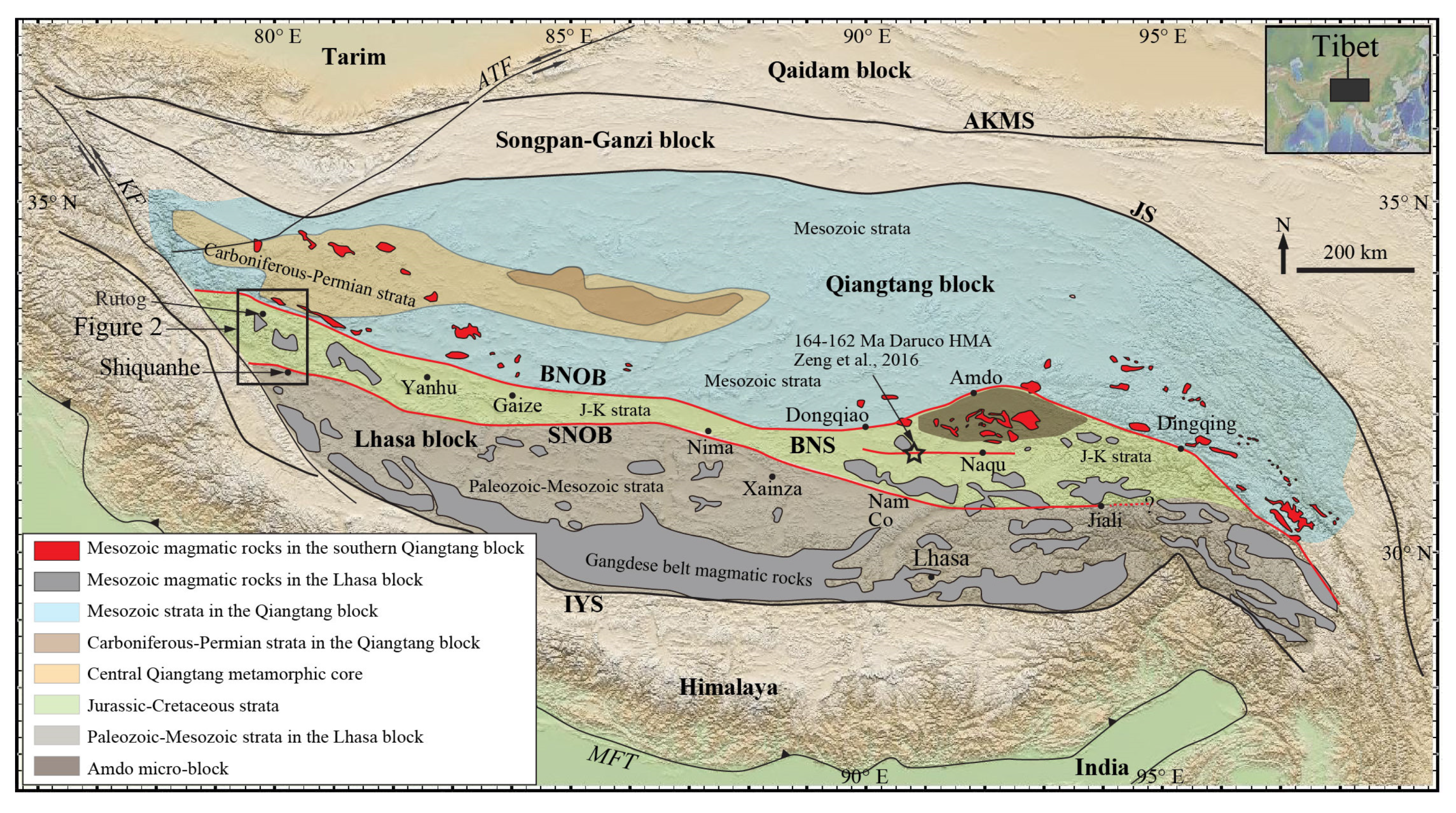
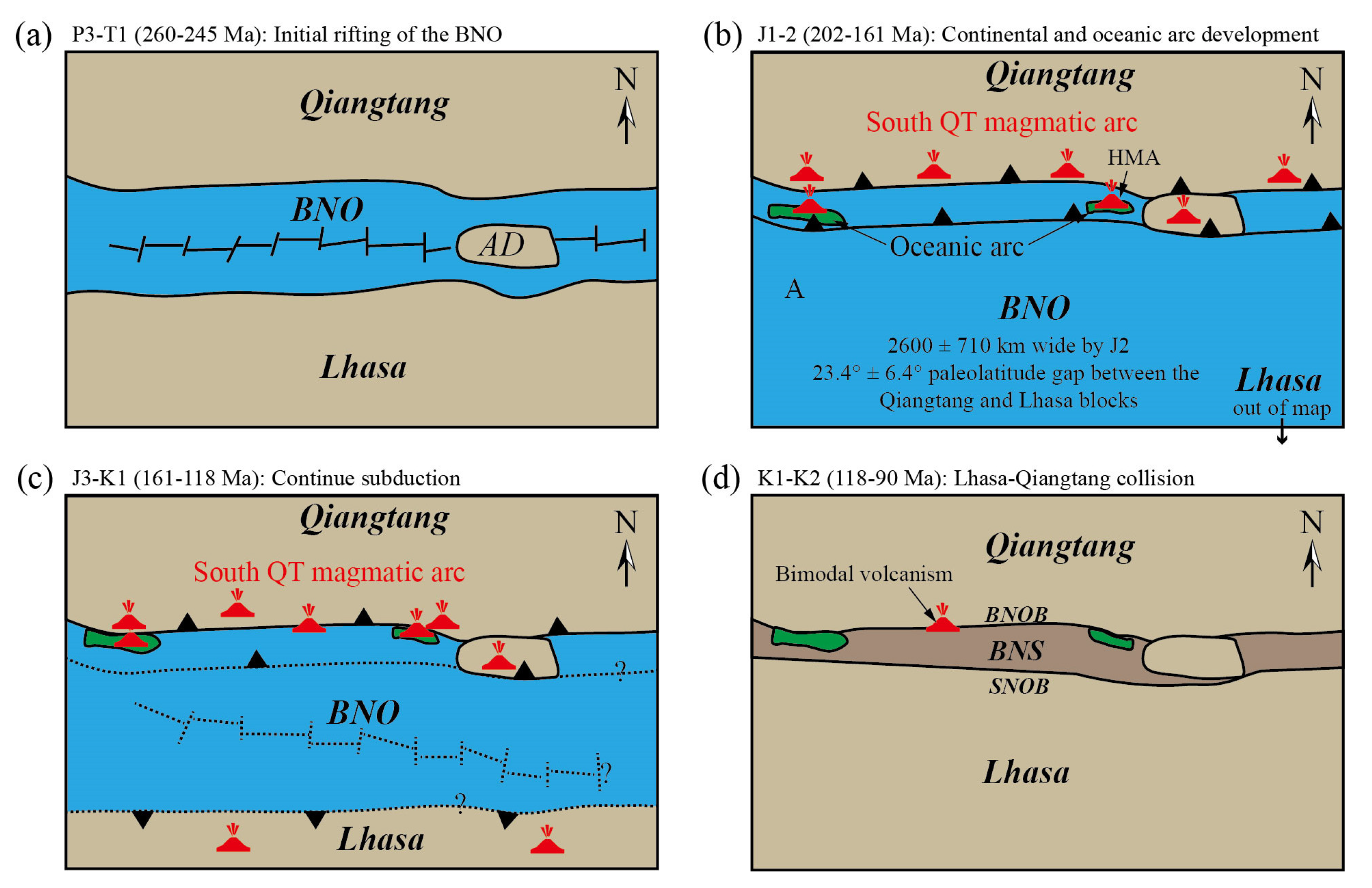
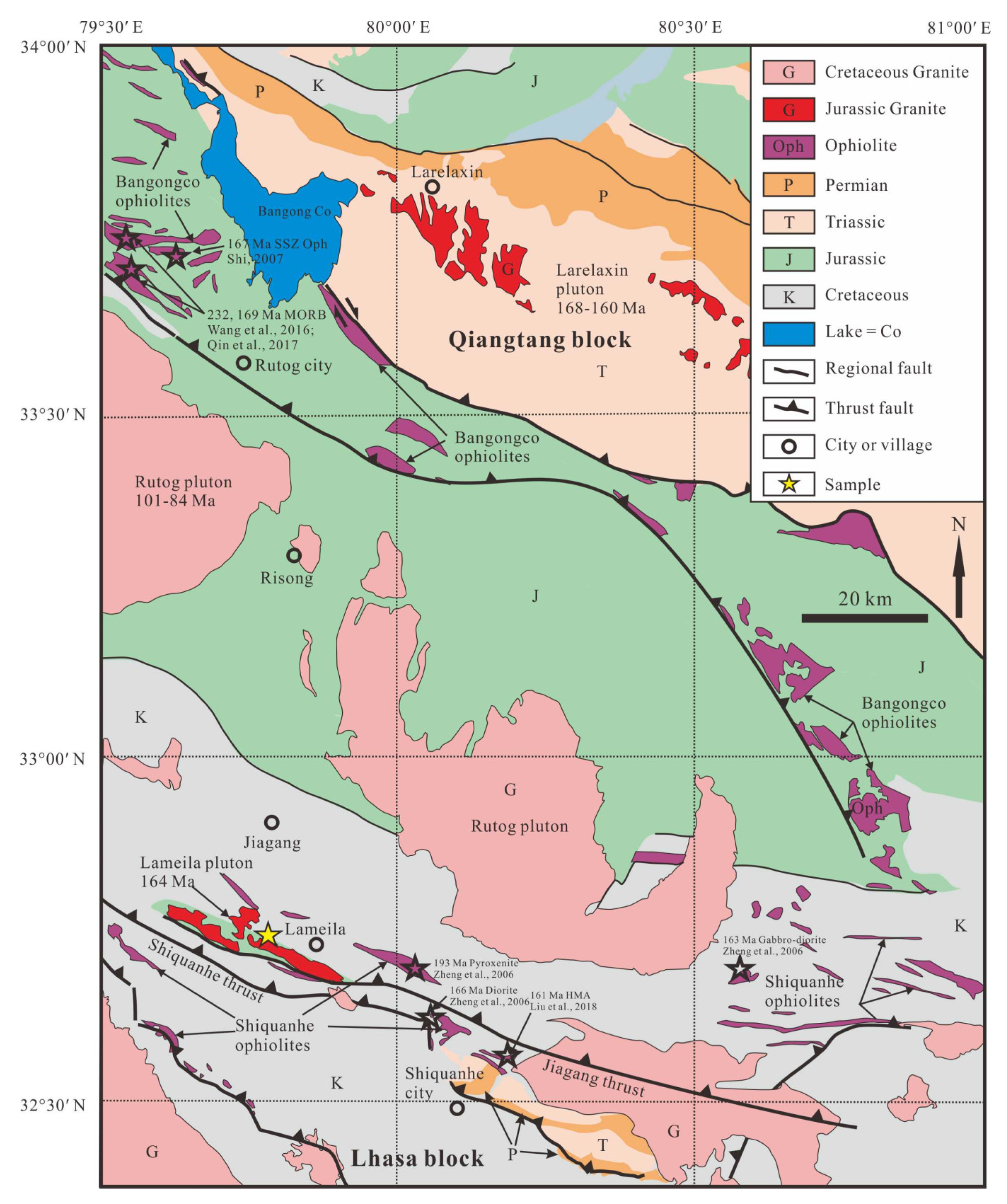
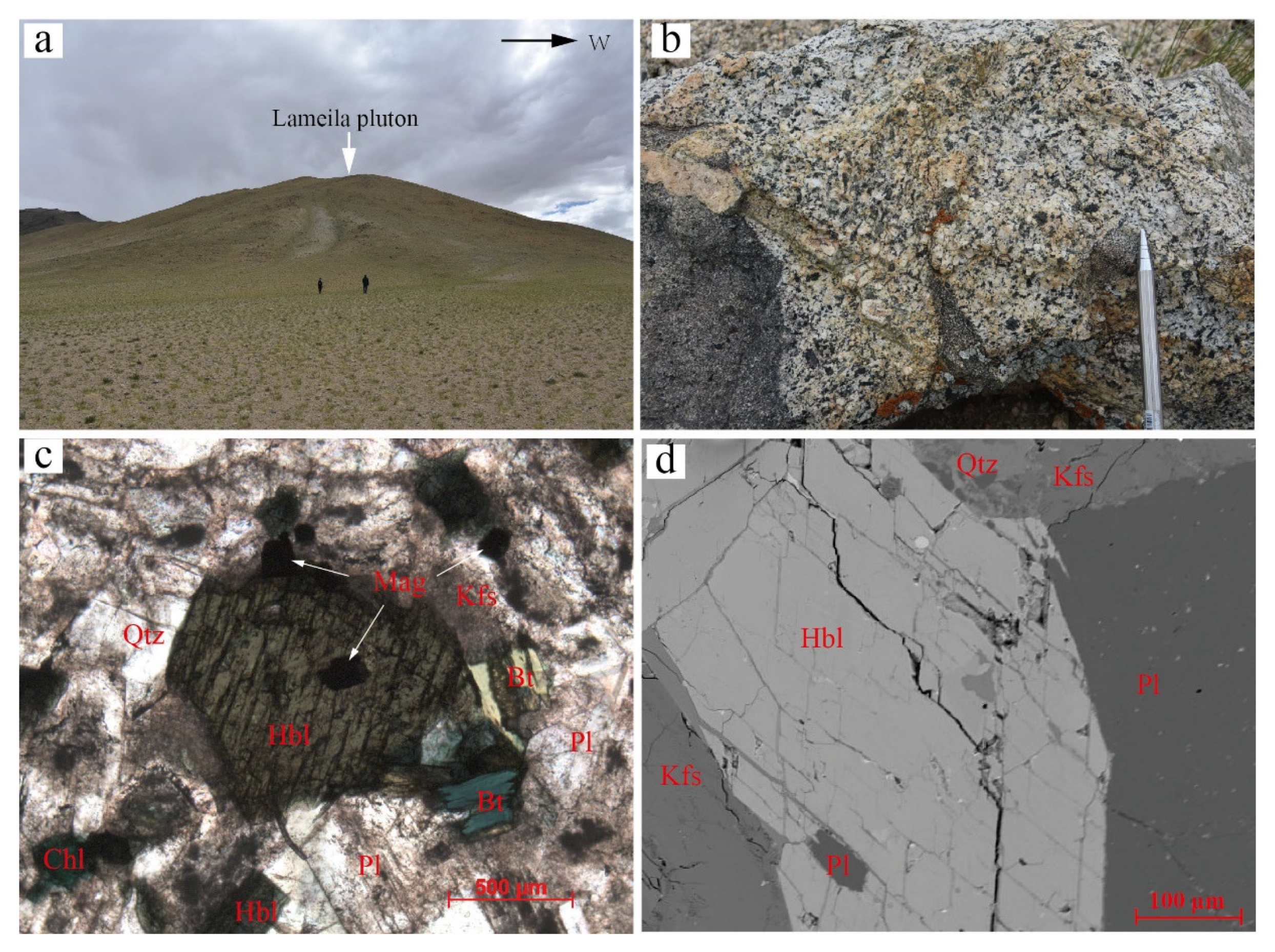
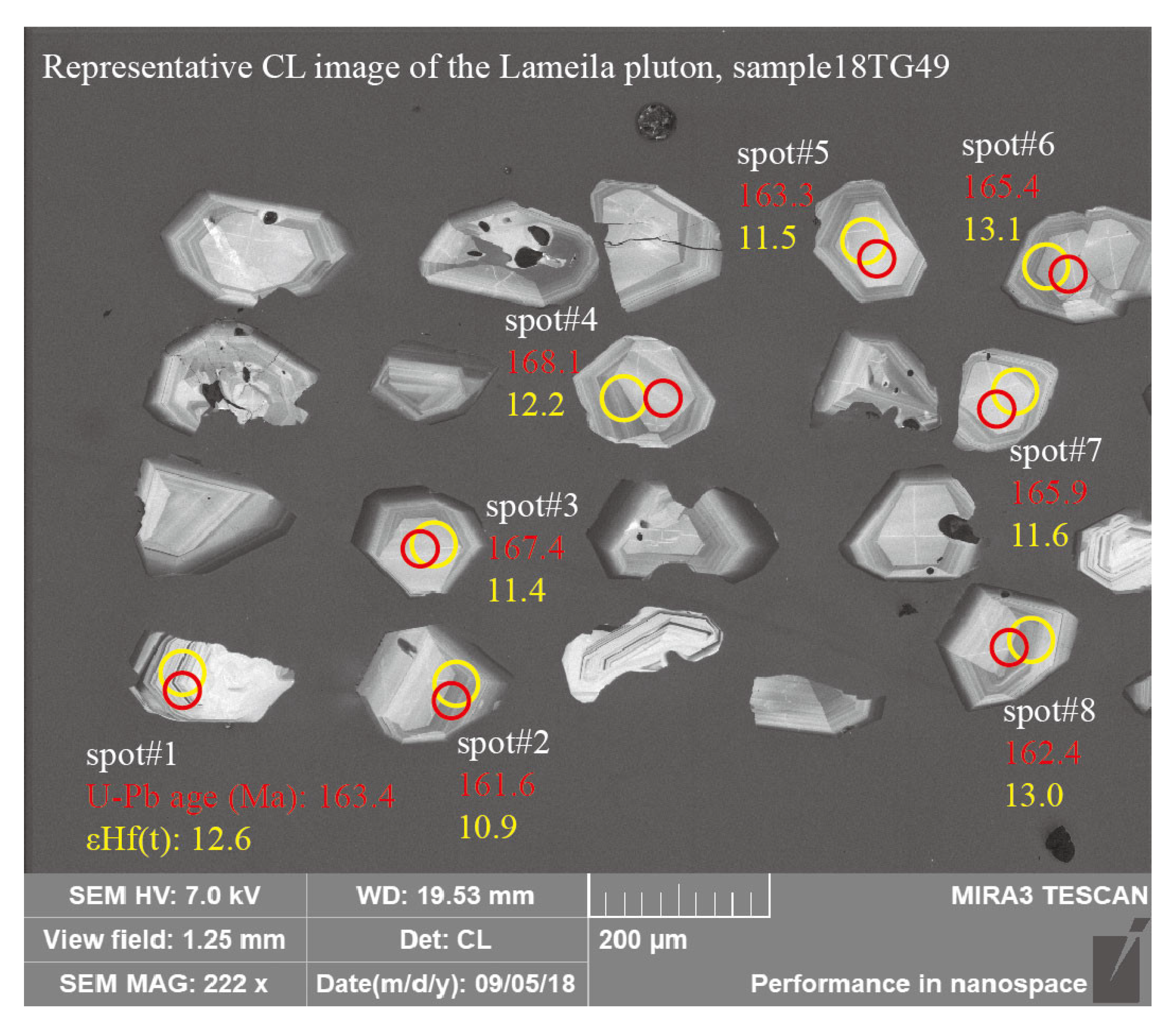
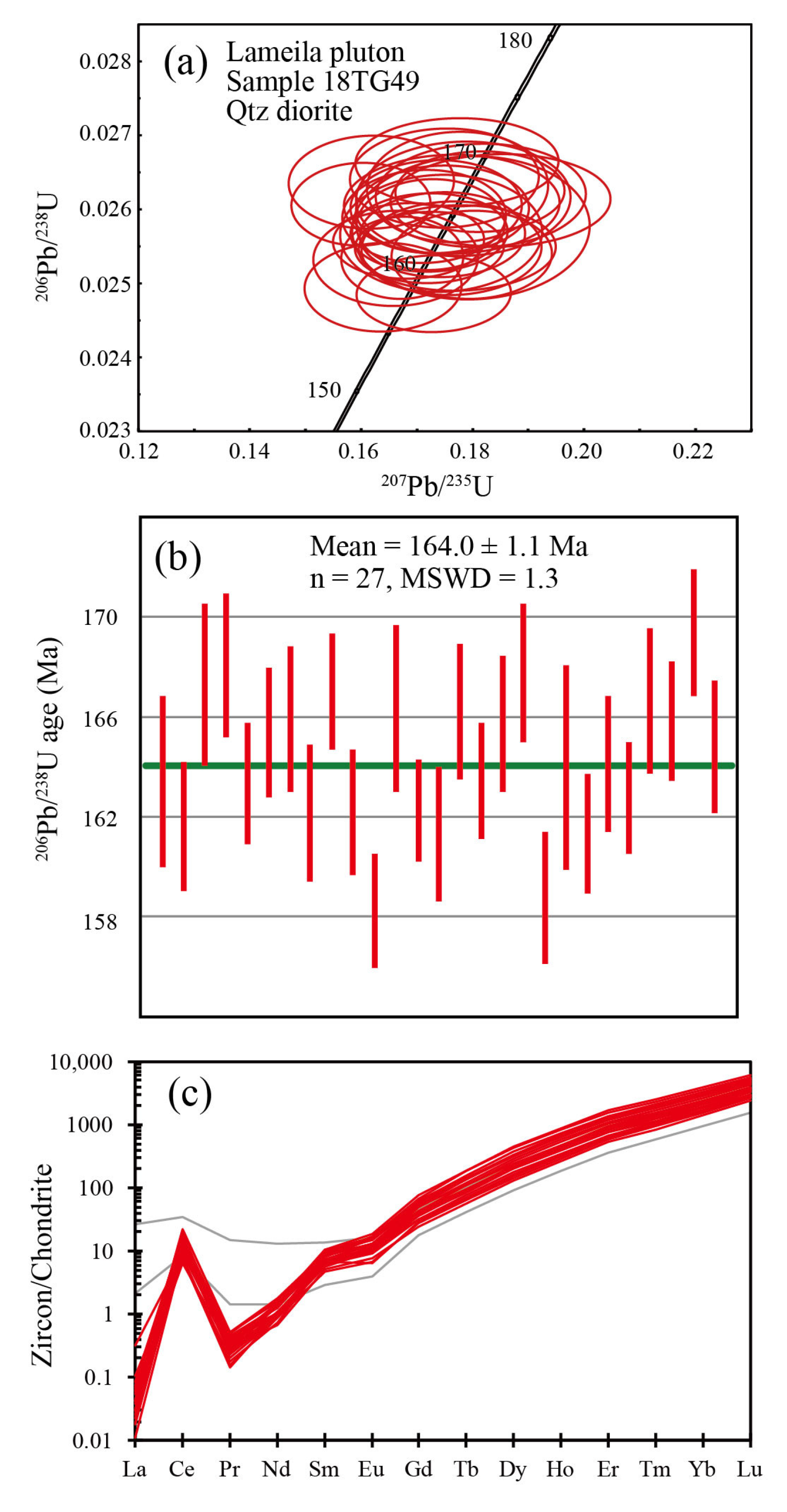
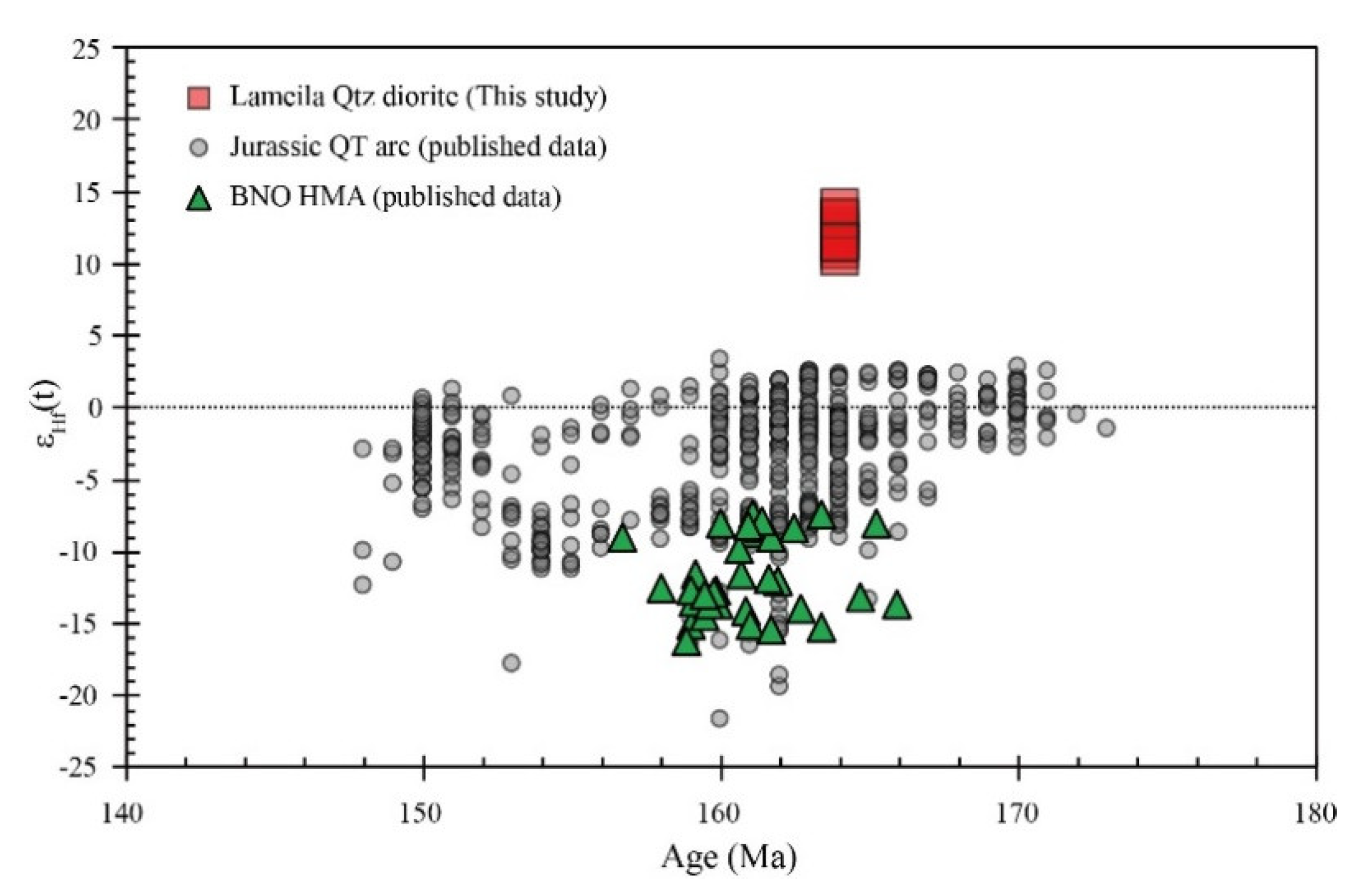
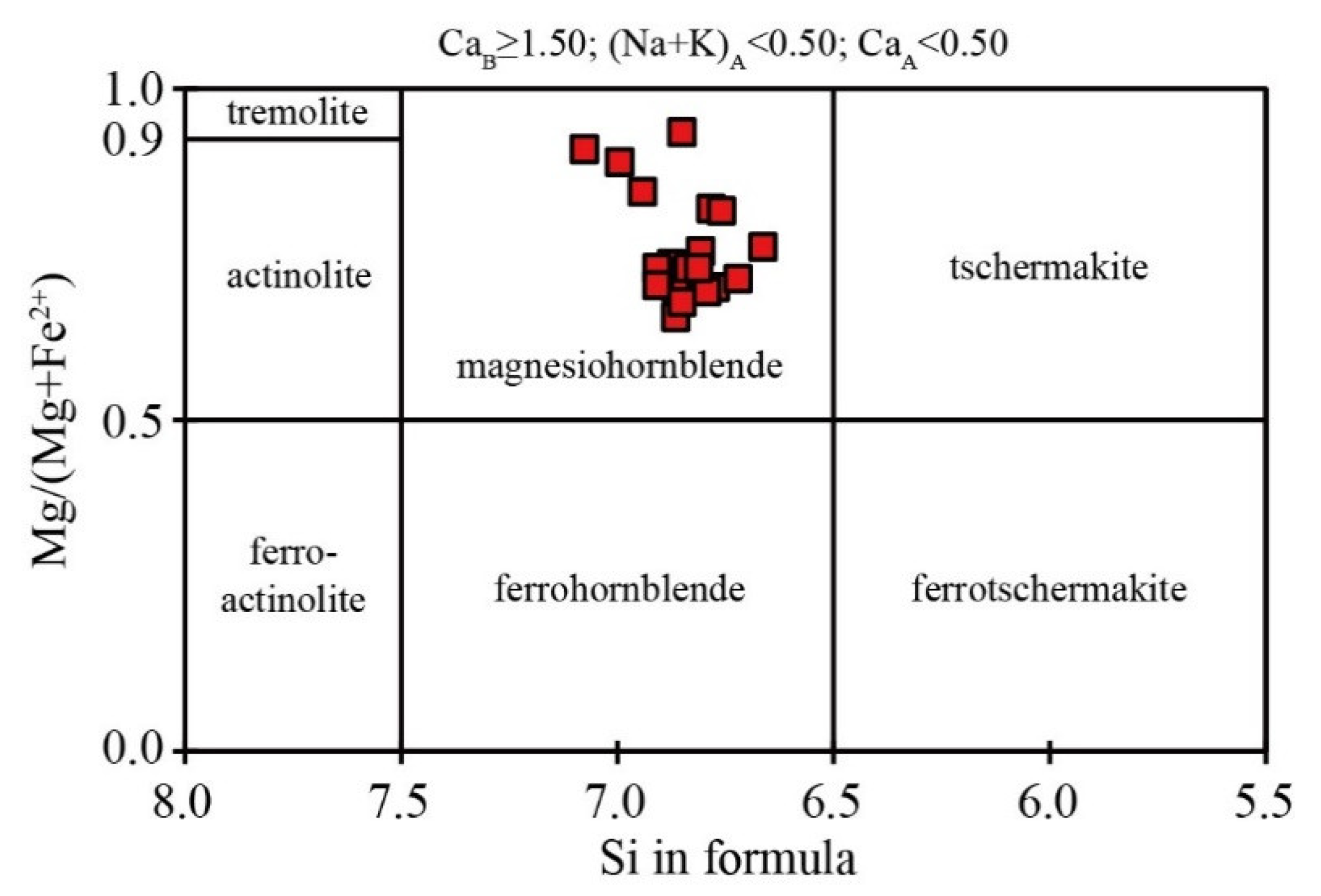

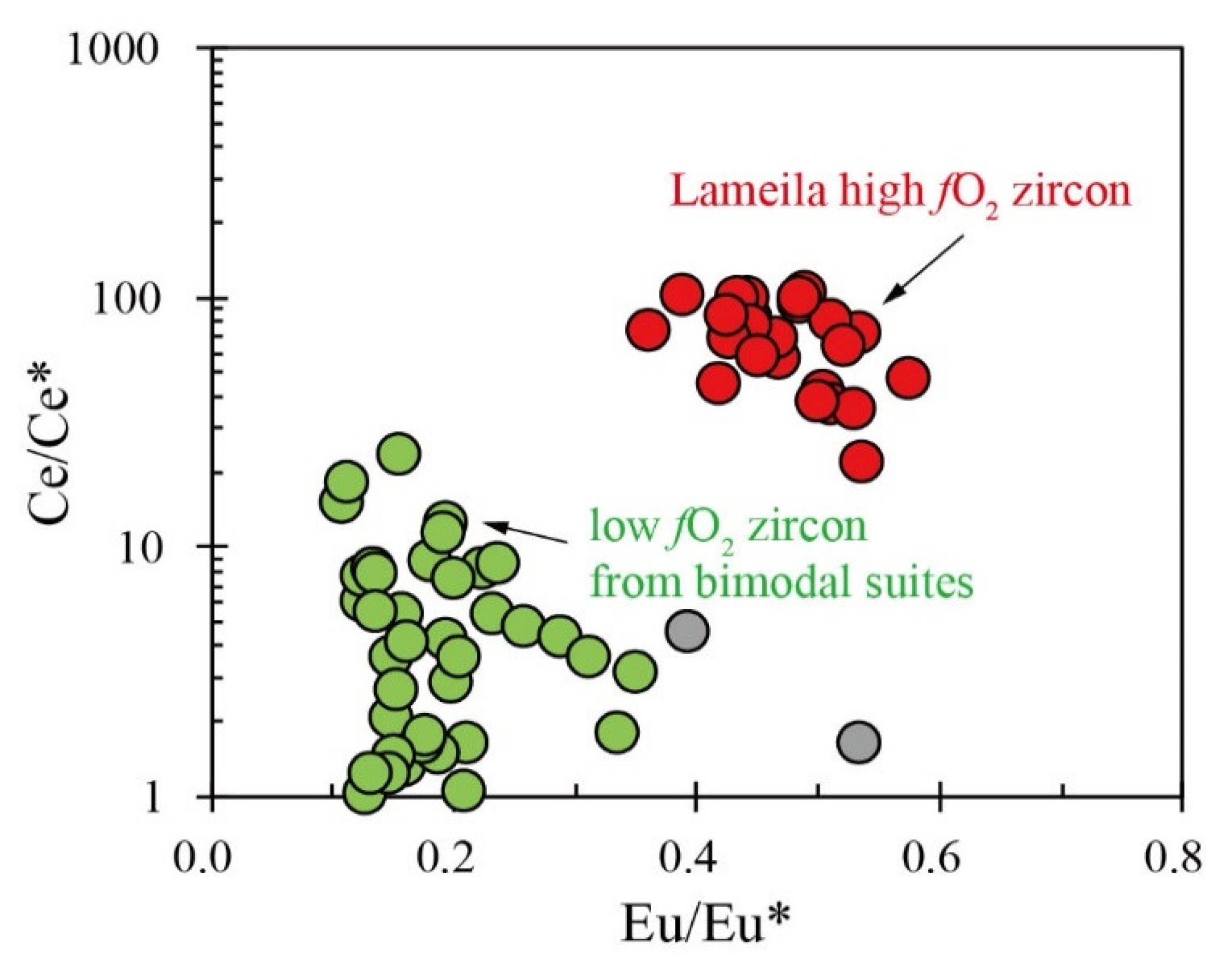
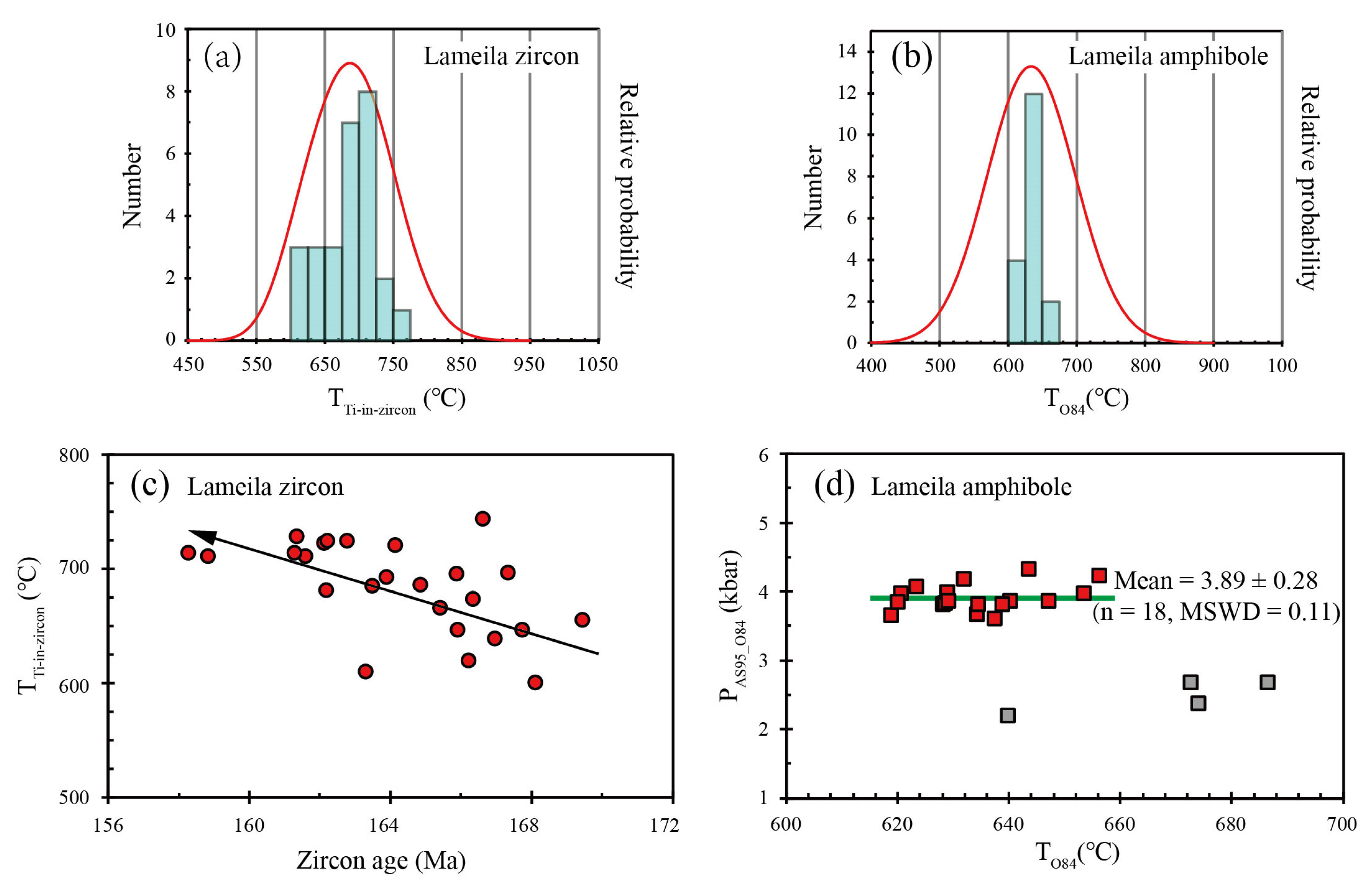
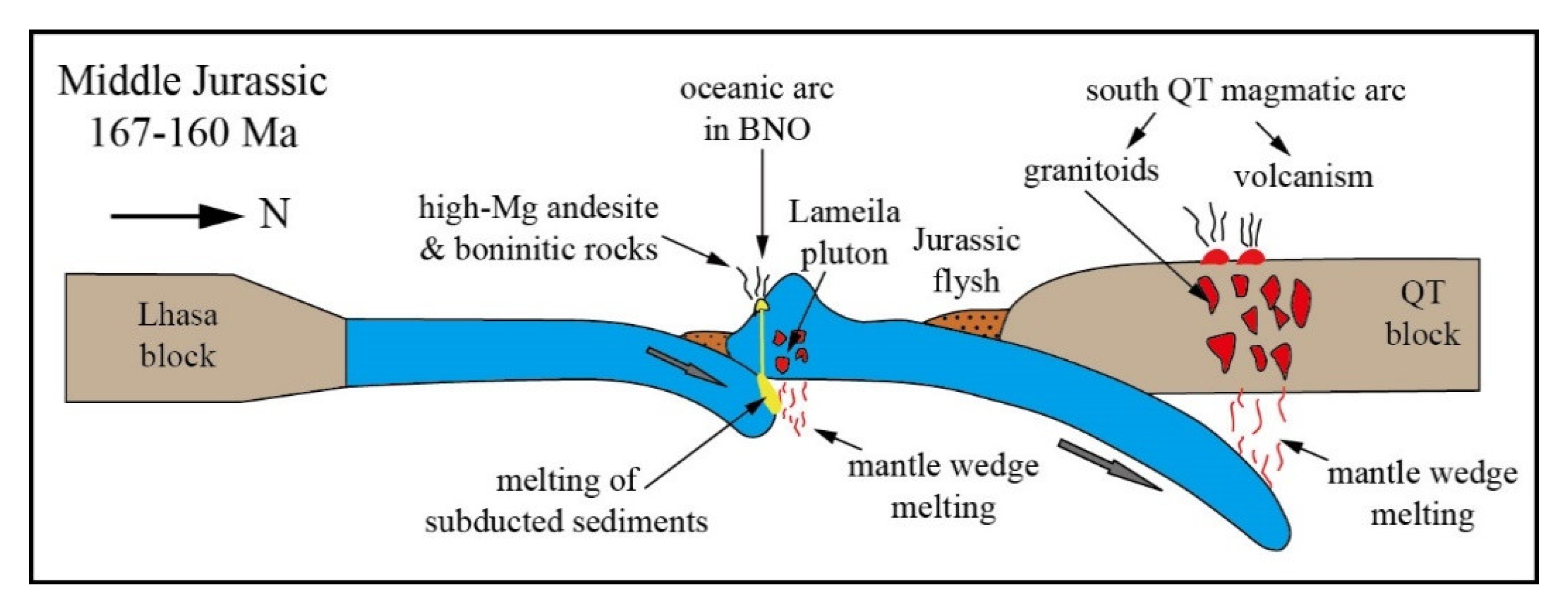
| Analysis | Th (ppm) | U (ppm) | Th/U | Isotope Ratios | Isotope Ages (Ma) | Discordant (%) | ||||||||||
|---|---|---|---|---|---|---|---|---|---|---|---|---|---|---|---|---|
| 207Pb/ 206Pb | 1s | 207Pb/ 235U | 1s | 206Pb/ 238U | 1s | 207Pb/ 206Pb | 1s | 207Pb/ 235U | 1s | 206Pb/ 238U | 1s | |||||
| TG-49-1 | 77.6 | 131 | 0.59 | 0.05031 | 0.00381 | 0.17434 | 0.01198 | 0.02568 | 0.00052 | 209.3 | 171.3 | 163.2 | 10.4 | 163.4 | 3.3 | 99% |
| TG-49-2 | 164 | 278 | 0.59 | 0.05090 | 0.00265 | 0.17982 | 0.00949 | 0.02539 | 0.00039 | 235.3 | 115.7 | 167.9 | 8.2 | 161.6 | 2.5 | 96% |
| TG-49-3 | 83.8 | 155 | 0.54 | 0.04984 | 0.00328 | 0.17730 | 0.01076 | 0.02630 | 0.00049 | 187.1 | 155.5 | 165.7 | 9.3 | 167.4 | 3.1 | 99% |
| TG-49-4 | 89.7 | 163 | 0.55 | 0.04776 | 0.00348 | 0.17494 | 0.01119 | 0.02642 | 0.00044 | 87.1 | 162.9 | 163.7 | 9.7 | 168.1 | 2.8 | 97% |
| TG-49-5 | 117 | 191 | 0.61 | 0.04956 | 0.00300 | 0.17455 | 0.00979 | 0.02566 | 0.00038 | 176.0 | 137.9 | 163.4 | 8.5 | 163.3 | 2.4 | 99% |
| TG-49-6 | 156 | 224 | 0.70 | 0.04879 | 0.00297 | 0.17458 | 0.01024 | 0.02600 | 0.00039 | 200.1 | 75.9 | 163.4 | 8.9 | 165.4 | 2.5 | 98% |
| TG-49-7 | 67.5 | 135 | 0.50 | 0.04839 | 0.00368 | 0.17626 | 0.01280 | 0.02607 | 0.00044 | 116.8 | 170.3 | 164.8 | 11.0 | 165.9 | 2.8 | 99% |
| TG-49-8 | 114 | 195 | 0.58 | 0.04969 | 0.00300 | 0.17621 | 0.01065 | 0.02547 | 0.00042 | 189.0 | 142.6 | 164.8 | 9.2 | 162.2 | 2.6 | 98% |
| TG-49-10 | 136 | 240 | 0.57 | 0.05038 | 0.00303 | 0.18133 | 0.01004 | 0.02624 | 0.00036 | 213.0 | 140.7 | 169.2 | 8.6 | 167.0 | 2.3 | 98% |
| TG-49-11 | 142 | 263 | 0.54 | 0.04984 | 0.00329 | 0.17727 | 0.01167 | 0.02548 | 0.00038 | 187.1 | 155.5 | 165.7 | 10.1 | 162.2 | 2.4 | 97% |
| TG-49-12 | 221 | 326 | 0.68 | 0.05038 | 0.00270 | 0.17300 | 0.00914 | 0.02486 | 0.00034 | 213.0 | 124.1 | 162.0 | 7.9 | 158.3 | 2.2 | 97% |
| TG-49-13 | 82.6 | 144 | 0.57 | 0.05000 | 0.00400 | 0.17835 | 0.01272 | 0.02614 | 0.00051 | 194.5 | 177.8 | 166.6 | 11.0 | 166.4 | 3.2 | 99% |
| TG-49-14 | 318 | 439 | 0.72 | 0.04824 | 0.00238 | 0.17222 | 0.00882 | 0.02548 | 0.00032 | 109.4 | 124.1 | 161.3 | 7.6 | 162.2 | 2.0 | 99% |
| TG-49-15 | 128 | 225 | 0.57 | 0.04745 | 0.00294 | 0.16620 | 0.00978 | 0.02534 | 0.00042 | 77.9 | 135.2 | 156.1 | 8.5 | 161.3 | 2.7 | 96% |
| TG-49-16 | 125 | 215 | 0.58 | 0.05128 | 0.00385 | 0.18500 | 0.01305 | 0.02612 | 0.00041 | 253.8 | 169.4 | 172.4 | 11.2 | 166.2 | 2.6 | 96% |
| TG-49-17 | 217 | 378 | 0.57 | 0.04843 | 0.00276 | 0.17221 | 0.00931 | 0.02569 | 0.00035 | 120.5 | 129.6 | 161.3 | 8.1 | 163.5 | 2.2 | 98% |
| TG-49-18 | 137 | 237 | 0.58 | 0.04818 | 0.00315 | 0.17349 | 0.01014 | 0.02604 | 0.00041 | 109.4 | 148.1 | 162.4 | 8.8 | 165.7 | 2.6 | 98% |
| TG-49-19 | 217 | 324 | 0.67 | 0.04392 | 0.00267 | 0.16182 | 0.00982 | 0.02637 | 0.00042 | error | error | 152.3 | 8.6 | 167.8 | 2.6 | 90% |
| TG-49-20 | 199 | 352 | 0.57 | 0.04723 | 0.00283 | 0.16394 | 0.00929 | 0.02495 | 0.00040 | 61.2 | 137.0 | 154.1 | 8.1 | 158.8 | 2.5 | 97% |
| TG-49-21 | 67.6 | 129 | 0.52 | 0.04950 | 0.00406 | 0.17970 | 0.01408 | 0.02575 | 0.00064 | 172.3 | 181.5 | 167.8 | 12.1 | 163.9 | 4.0 | 97% |
| TG-49-22 | 311 | 459 | 0.68 | 0.04772 | 0.00219 | 0.16739 | 0.00723 | 0.02535 | 0.00037 | 87.1 | 103.7 | 157.2 | 6.3 | 161.4 | 2.3 | 97% |
| TG-49-23 | 213 | 350 | 0.61 | 0.04815 | 0.00248 | 0.17252 | 0.00879 | 0.02579 | 0.00041 | 105.6 | 127.8 | 161.6 | 7.6 | 164.2 | 2.6 | 98% |
| TG-49-24 | 257 | 379 | 0.68 | 0.04773 | 0.00263 | 0.16848 | 0.00896 | 0.02557 | 0.00034 | 87.1 | 125.9 | 158.1 | 7.8 | 162.8 | 2.1 | 97% |
| TG-49-27 | 103 | 176 | 0.58 | 0.05028 | 0.00381 | 0.18149 | 0.01243 | 0.02619 | 0.00046 | 209.3 | 171.3 | 169.3 | 10.7 | 166.6 | 2.9 | 98% |
| TG-49-28 | 219 | 331 | 0.66 | 0.04438 | 0.00236 | 0.15994 | 0.00824 | 0.02607 | 0.00037 | error | error | 150.6 | 7.2 | 165.9 | 2.3 | 90% |
| TG-49-29 | 123 | 217 | 0.57 | 0.04769 | 0.00320 | 0.17719 | 0.01204 | 0.02664 | 0.00039 | 83.4 | 151.8 | 165.6 | 10.4 | 169.5 | 2.5 | 97% |
| TG-49-30 | 186 | 302 | 0.62 | 0.04790 | 0.00280 | 0.17132 | 0.00971 | 0.02591 | 0.00041 | 94.5 | 133.3 | 160.6 | 8.4 | 164.9 | 2.6 | 97% |
| Spot | Ti | La | Ce | Pr | Nd | Sm | Eu | Gd | Tb | Dy | Ho | Er | Tm | Yb | Lu |
|---|---|---|---|---|---|---|---|---|---|---|---|---|---|---|---|
| TG-49-1 | 5.89 | 0.5 | 5.1 | 0.14 | 0.66 | 0.44 | 0.23 | 3.62 | 1.53 | 23.21 | 10.45 | 58.87 | 14.69 | 161.1 | 40.03 |
| TG-49-2 | 7.02 | 0.01 | 7.89 | 0.02 | 0.51 | 0.96 | 0.69 | 8.75 | 4.06 | 66.63 | 30.52 | 170 | 40.01 | 415 | 101 |
| TG-49-3 | 5.87 | 0.01 | 4.54 | 0.02 | 0.4 | 0.98 | 0.59 | 6.56 | 2.54 | 39.26 | 18.04 | 103 | 25.39 | 277.0 | 70.97 |
| TG-49-4 | 1.56 | 0 | 4.63 | 0.01 | 0.47 | 0.93 | 0.53 | 6.44 | 2.65 | 41.27 | 18.82 | 108 | 26.52 | 286 | 73.25 |
| TG-49-5 | 1.81 | 0 | 5.68 | 0.04 | 0.49 | 1.02 | 0.64 | 7.64 | 3.4 | 50.83 | 22.36 | 124 | 29.57 | 314 | 77.54 |
| TG-49-6 | 3.96 | 0.01 | 6.75 | 0.05 | 0.82 | 1.42 | 0.89 | 10.54 | 4.07 | 60.54 | 26.81 | 147 | 34.56 | 363 | 89.11 |
| TG-49-7 | 3.07 | 0.01 | 3.87 | 0.03 | 0.32 | 0.78 | 0.45 | 5.01 | 2.09 | 33.26 | 15.22 | 88.5 | 21.63 | 239 | 60.21 |
| TG-49-8 | 8.04 | 0.01 | 5.64 | 0.03 | 0.45 | 0.84 | 0.58 | 7.62 | 3.15 | 50.55 | 22.63 | 129 | 31.06 | 332 | 81.54 |
| TG-49-10 | 2.76 | 0 | 6.55 | 0.02 | 0.43 | 0.97 | 0.54 | 7.39 | 3.32 | 52.94 | 24.4 | 139.7 | 33.93 | 363.0 | 88.88 |
| TG-49-11 | 4.84 | 0 | 7.28 | 0.03 | 0.44 | 0.98 | 0.64 | 7.58 | 3.28 | 58.31 | 26.5 | 154 | 37.16 | 397 | 96.92 |
| TG-49-12 | 7.3 | 0.01 | 9.09 | 0.04 | 0.66 | 1.24 | 0.89 | 12.89 | 5.28 | 82.71 | 36.28 | 200 | 46.44 | 483 | 115 |
| TG-49-13 | 4.4 | 0.01 | 4.98 | 0.02 | 0.35 | 1.01 | 0.36 | 5.81 | 2.42 | 38.97 | 17.51 | 102.7 | 25.96 | 286 | 71.75 |
| TG-49-14 | 8.23 | 0.02 | 11.99 | 0.03 | 0.69 | 1.62 | 1.1 | 15.4 | 6.81 | 107 | 47.3 | 259 | 58.79 | 609 | 143 |
| TG-49-15 | 7.23 | 0.01 | 6.47 | 0.03 | 0.42 | 1.38 | 0.72 | 8.01 | 3.42 | 56.47 | 25.6 | 151 | 36.42 | 394 | 97.83 |
| TG-49-16 | 2.09 | 0.02 | 6.39 | 0.04 | 0.59 | 1.26 | 0.74 | 8.79 | 3.58 | 55.17 | 24.96 | 145 | 34.48 | 378 | 95.16 |
| TG-49-17 | 5.06 | 0.01 | 10.24 | 0.03 | 0.67 | 1.28 | 0.76 | 10.62 | 5.09 | 85.17 | 39.26 | 224 | 52.43 | 554 | 134 |
| TG-49-18 | 11.3 | 6.15 | 20.91 | 1.4 | 6 | 2.1 | 0.94 | 9.67 | 3.71 | 59.55 | 27.09 | 154 | 37.35 | 404 | 101 |
| TG-49-19 | 3.06 | 0.02 | 9.2 | 0.03 | 0.69 | 1.57 | 0.95 | 12.29 | 5.1 | 80.69 | 36.14 | 209 | 49.3 | 527 | 130 |
| TG-49-20 | 7.06 | 0.01 | 9.58 | 0.03 | 0.63 | 1.38 | 0.92 | 11.54 | 5.2 | 83.23 | 37.23 | 214 | 50.63 | 545 | 132 |
| TG-49-21 | 5.58 | 0.02 | 4.33 | 0.02 | 0.42 | 0.73 | 0.39 | 5.6 | 2.43 | 35.71 | 16.05 | 94.67 | 24.02 | 268 | 68.25 |
| TG-49-22 | 8.62 | 0.01 | 13.4 | 0.05 | 0.72 | 1.36 | 0.98 | 13.83 | 6.78 | 113 | 50.14 | 276 | 63.66 | 656 | 156 |
| TG-49-23 | 7.88 | 0.01 | 10.16 | 0.04 | 0.6 | 1.12 | 0.77 | 11.21 | 5.09 | 84.17 | 37.73 | 211 | 49.78 | 517 | 126 |
| TG-49-24 | 8.28 | 0.02 | 11.04 | 0.03 | 0.6 | 1.52 | 0.89 | 12.78 | 5.72 | 94.2 | 41.68 | 228 | 52.92 | 548 | 132 |
| TG-49-27 | 10.25 | 0.08 | 5.27 | 0.04 | 0.46 | 1.08 | 0.61 | 6.56 | 2.8 | 44.17 | 19.46 | 112 | 27.12 | 287 | 72.33 |
| TG-49-28 | 5.81 | 0.01 | 10.01 | 0.05 | 0.79 | 1.49 | 0.85 | 11.44 | 5.1 | 84.35 | 37.16 | 205 | 47.97 | 493 | 118 |
| TG-49-29 | 3.45 | 0.01 | 6.05 | 0.04 | 0.45 | 1.14 | 0.74 | 7.56 | 3.27 | 53.26 | 24.71 | 140 | 33.63 | 356 | 89.29 |
| TG-49-30 | 5.14 | 0.01 | 8.73 | 0.02 | 0.49 | 1.11 | 0.63 | 9.91 | 4.44 | 73.33 | 32.92 | 181 | 42.8 | 446 | 108 |
| Spot | Age (Ma) | 176Hf/ 177Hf | 2σ | 176Yb/ 177Hf | 2σ | 176Lu/ 177Hf | 2σ | (176Hf/ 177Hf)i | εHf(t) | TDM (Ma) | TDMC (Ma) |
|---|---|---|---|---|---|---|---|---|---|---|---|
| 18TG-49-1 | 164 | 0.283028 | 0.000013 | 0.006345 | 0.000118 | 0.000327 | 0.000006 | 0.283027 | 12.6 | 312 | 405 |
| 18TG-49-2 | 164 | 0.282985 | 0.000020 | 0.035704 | 0.000358 | 0.001775 | 0.000015 | 0.282980 | 10.9 | 386 | 512 |
| 18TG-49-3 | 164 | 0.282998 | 0.000016 | 0.033158 | 0.000295 | 0.001620 | 0.000015 | 0.282993 | 11.4 | 367 | 482 |
| 18TG-49-4 | 164 | 0.283019 | 0.000015 | 0.032713 | 0.000422 | 0.001657 | 0.000020 | 0.283014 | 12.2 | 336 | 433 |
| 18TG-49-5 | 164 | 0.283000 | 0.000016 | 0.031823 | 0.000122 | 0.001578 | 0.000010 | 0.282995 | 11.5 | 363 | 477 |
| 18TG-49-6 | 164 | 0.283047 | 0.000014 | 0.035129 | 0.000156 | 0.001746 | 0.000008 | 0.283042 | 13.1 | 296 | 371 |
| 18TG-49-7 | 164 | 0.283001 | 0.000016 | 0.024398 | 0.000150 | 0.001198 | 0.000005 | 0.282997 | 11.6 | 358 | 473 |
| 18TG-49-8 | 164 | 0.283042 | 0.000017 | 0.032354 | 0.000163 | 0.001599 | 0.000013 | 0.283037 | 13.0 | 302 | 381 |
| 18TG-49-10 | 164 | 0.282972 | 0.000015 | 0.039386 | 0.000686 | 0.001887 | 0.000033 | 0.282966 | 10.5 | 407 | 542 |
| 18TG-49-11 | 164 | 0.283068 | 0.000016 | 0.037275 | 0.000264 | 0.001773 | 0.000014 | 0.283063 | 13.9 | 265 | 323 |
| 18TG-49-12 | 164 | 0.282999 | 0.000018 | 0.030743 | 0.000285 | 0.001501 | 0.000012 | 0.282994 | 11.5 | 364 | 479 |
| Spot | TG50-1 | TG50-2 | TG50-3 | TG50-4 | TG50-5 | TG50-6 | TG50-7 | TG50-8 | TG51-1 | TG51-2 | TG51-3 |
|---|---|---|---|---|---|---|---|---|---|---|---|
| SiO2 | 46.05 | 47.05 | 48.14 | 46.62 | 47.02 | 46.96 | 46.44 | 46.06 | 47.32 | 46.64 | 49.84 |
| TiO2 | 0.57 | 0.63 | 1.10 | 0.63 | 0.68 | 0.70 | 0.76 | 0.63 | 0.56 | 0.59 | 0.74 |
| Al2O3 | 8.09 | 7.98 | 7.23 | 7.97 | 7.87 | 7.77 | 8.81 | 8.11 | 7.79 | 8.21 | 6.32 |
| FeOtotal | 17.00 | 15.13 | 13.58 | 15.87 | 15.86 | 16.19 | 17.25 | 16.26 | 15.66 | 16.23 | 12.52 |
| MnO | 0.71 | 0.69 | 0.45 | 0.72 | 0.73 | 0.78 | 0.81 | 0.72 | 0.59 | 0.52 | 0.43 |
| MgO | 11.82 | 12.65 | 14.91 | 12.25 | 12.57 | 12.20 | 12.18 | 12.01 | 12.52 | 11.81 | 15.41 |
| CaO | 11.50 | 11.25 | 10.30 | 11.14 | 11.59 | 11.56 | 11.13 | 11.70 | 11.45 | 11.88 | 10.54 |
| Na2O | 0.87 | 1.07 | 1.15 | 1.10 | 1.07 | 0.94 | 1.14 | 0.90 | 0.99 | 0.93 | 0.99 |
| K2O | 0.55 | 0.46 | 0.22 | 0.51 | 0.32 | 0.47 | 0.30 | 0.57 | 0.29 | 0.58 | 0.16 |
| Total (wt %) | 97.16 | 96.91 | 97.08 | 96.81 | 97.71 | 97.57 | 98.82 | 96.96 | 97.17 | 97.39 | 96.95 |
| Formulae based on 23 oxygen and 13eCNK. | |||||||||||
| T site | |||||||||||
| Si | 6.77 | 6.87 | 6.84 | 6.84 | 6.84 | 6.86 | 6.66 | 6.79 | 6.90 | 6.86 | 7.07 |
| Al(IV) | 1.23 | 1.13 | 1.16 | 1.16 | 1.16 | 1.14 | 1.34 | 1.21 | 1.10 | 1.14 | 0.93 |
| C site | |||||||||||
| Al(VI) | 0.17 | 0.24 | 0.05 | 0.22 | 0.18 | 0.19 | 0.15 | 0.20 | 0.24 | 0.28 | 0.13 |
| Ti | 0.06 | 0.07 | 0.12 | 0.07 | 0.07 | 0.08 | 0.08 | 0.07 | 0.06 | 0.07 | 0.08 |
| Fe3+ | 0.96 | 0.84 | 1.37 | 0.90 | 0.86 | 0.82 | 1.24 | 0.81 | 0.83 | 0.61 | 1.14 |
| Mg | 2.59 | 2.75 | 3.16 | 2.68 | 2.72 | 2.66 | 2.60 | 2.64 | 2.72 | 2.59 | 3.26 |
| Fe2+ | 1.13 | 1.01 | 0.24 | 1.05 | 1.07 | 1.15 | 0.83 | 1.19 | 1.08 | 1.39 | 0.34 |
| Mn | 0.09 | 0.09 | 0.05 | 0.09 | 0.09 | 0.10 | 0.10 | 0.09 | 0.07 | 0.06 | 0.05 |
| B site | |||||||||||
| Ca | 1.81 | 1.76 | 1.57 | 1.75 | 1.81 | 1.81 | 1.71 | 1.85 | 1.79 | 1.87 | 1.60 |
| Na | 0.19 | 0.24 | 0.32 | 0.25 | 0.19 | 0.19 | 0.29 | 0.15 | 0.21 | 0.13 | 0.27 |
| A site | |||||||||||
| Na | 0.06 | 0.06 | 0.00 | 0.06 | 0.11 | 0.07 | 0.03 | 0.10 | 0.07 | 0.14 | 0.00 |
| K | 0.10 | 0.09 | 0.04 | 0.10 | 0.06 | 0.09 | 0.05 | 0.11 | 0.05 | 0.11 | 0.03 |
| Pressure (kbar), temperature (°C), and depth (km) of emplacement at a crustal density of 2.95 g/cm3 | |||||||||||
| TO84 | 621 | 628 | 687 | 629 | 635 | 638 | 644 | 629 | 619 | 624 | 640 |
| TEL98 | 666 | 633 | 642 | 644 | 644 | 638 | 701 | 659 | 624 | 636 | 569 |
| PHZ86 | 3.1 | 3.0 | 2.2 | 3.0 | 2.9 | 2.8 | 3.6 | 3.2 | 2.8 | 3.2 | 1.4 |
| PJR89 | 2.5 | 2.3 | 1.7 | 2.4 | 2.2 | 2.2 | 2.8 | 2.5 | 2.2 | 2.6 | 1.0 |
| PS92 | 3.7 | 3.5 | 2.8 | 3.5 | 3.4 | 3.4 | 4.1 | 3.7 | 3.4 | 3.8 | 2.0 |
| PA97_S92 | 3.6 | 3.5 | 2.9 | 3.5 | 3.4 | 3.3 | 3.9 | 3.6 | 3.3 | 3.6 | 2.3 |
| PEL98 | 4.6 | 6.3 | 4.7 | 6.0 | 4.8 | 4.9 | 5.6 | 4.4 | 5.8 | 5.3 | 5.1 |
| PH87 | 3.1 | 3.0 | 2.1 | 3.0 | 2.8 | 2.8 | 3.6 | 3.2 | 2.8 | 3.3 | 1.2 |
| PAS95_O84 | 4.0 | 3.8 | 2.7 | 3.8 | 3.6 | 3.6 | 4.3 | 4.0 | 3.6 | 4.1 | 2.2 |
| Depth | 13.4 | 12.9 | 9.0 | 12.9 | 12.4 | 12.1 | 14.6 | 13.4 | 12.3 | 13.8 | 7.4 |
| Spot | TG51-4 | TG51-5 | TG51-6 | TG51-7 | TG51-8 | TG52-1 | TG52-2 | TG52-3 | TG52-4 | TG52-5 | TG52-6 |
| SiO2 | 45.53 | 47.15 | 47.26 | 46.75 | 47.45 | 48.14 | 45.87 | 46.71 | 46.95 | 48.96 | 46.77 |
| TiO2 | 0.64 | 0.72 | 0.71 | 0.57 | 0.79 | 0.98 | 0.84 | 0.83 | 0.68 | 1.00 | 0.64 |
| Al2O3 | 8.18 | 8.06 | 8.02 | 8.02 | 8.30 | 6.99 | 8.61 | 8.38 | 8.04 | 6.70 | 8.06 |
| FeOtotal | 15.07 | 13.90 | 15.50 | 15.96 | 15.35 | 13.69 | 16.11 | 14.46 | 15.31 | 12.93 | 15.80 |
| MnO | 0.55 | 0.52 | 0.59 | 0.53 | 0.60 | 0.47 | 0.72 | 0.53 | 0.76 | 0.40 | 0.74 |
| MgO | 11.91 | 13.12 | 12.26 | 12.70 | 13.29 | 14.25 | 12.10 | 13.54 | 12.71 | 14.97 | 12.56 |
| CaO | 11.49 | 11.36 | 11.37 | 11.27 | 10.93 | 10.87 | 11.44 | 10.92 | 11.57 | 10.54 | 11.51 |
| Na2O | 1.03 | 1.33 | 0.96 | 0.94 | 0.97 | 0.94 | 1.06 | 1.30 | 1.07 | 1.05 | 1.06 |
| K2O | 0.60 | 0.49 | 0.45 | 0.48 | 0.37 | 0.23 | 0.59 | 0.41 | 0.46 | 0.19 | 0.41 |
| Total (wt %) | 95.00 | 96.65 | 97.12 | 97.22 | 98.05 | 96.56 | 97.34 | 97.08 | 97.55 | 96.74 | 97.55 |
| Formulae based on 23 oxygen and 13eCNK | |||||||||||
| T site | |||||||||||
| Si | 6.84 | 6.90 | 6.90 | 6.80 | 6.78 | 6.94 | 6.72 | 6.75 | 6.83 | 6.99 | 6.81 |
| Al(IV) | 1.16 | 1.10 | 1.10 | 1.20 | 1.22 | 1.06 | 1.28 | 1.25 | 1.17 | 1.01 | 1.19 |
| C site | |||||||||||
| Al(VI) | 0.29 | 0.29 | 0.29 | 0.18 | 0.18 | 0.12 | 0.20 | 0.18 | 0.21 | 0.12 | 0.19 |
| Ti | 0.07 | 0.08 | 0.08 | 0.06 | 0.08 | 0.11 | 0.09 | 0.09 | 0.07 | 0.11 | 0.07 |
| Fe3+ | 0.60 | 0.62 | 0.74 | 1.03 | 1.19 | 1.06 | 0.89 | 1.07 | 0.81 | 1.13 | 0.90 |
| Mg | 2.67 | 2.86 | 2.67 | 2.75 | 2.83 | 3.06 | 2.64 | 2.92 | 2.76 | 3.19 | 2.73 |
| Fe2+ | 1.29 | 1.09 | 1.15 | 0.91 | 0.64 | 0.59 | 1.08 | 0.68 | 1.05 | 0.41 | 1.03 |
| Mn | 0.07 | 0.06 | 0.07 | 0.07 | 0.07 | 0.06 | 0.09 | 0.06 | 0.09 | 0.05 | 0.09 |
| B site | |||||||||||
| Ca | 1.85 | 1.78 | 1.78 | 1.76 | 1.67 | 1.68 | 1.79 | 1.69 | 1.80 | 1.61 | 1.79 |
| Na | 0.15 | 0.22 | 0.22 | 0.24 | 0.27 | 0.26 | 0.21 | 0.31 | 0.20 | 0.29 | 0.21 |
| A site | |||||||||||
| Na | 0.15 | 0.16 | 0.05 | 0.02 | 0.00 | 0.00 | 0.10 | 0.06 | 0.11 | 0.00 | 0.09 |
| K | 0.12 | 0.09 | 0.08 | 0.09 | 0.07 | 0.04 | 0.11 | 0.08 | 0.09 | 0.03 | 0.08 |
| Pressure (kbar), temperature (°C). and depth (km) of emplacement at a crustal density of 2.95 g/cm3 | |||||||||||
| TO84 | 632 | 640 | 639 | 620 | 647 | 673 | 656 | 654 | 635 | 674 | 629 |
| TEL98 | 641 | 623 | 622 | 655 | 662 | 612 | 682 | 671 | 645 | 595 | 653 |
| PHZ86 | 3.4 | 3.1 | 3.0 | 3.0 | 3.1 | 2.1 | 3.6 | 3.3 | 3.0 | 1.7 | 3.0 |
| PJR89 | 2.7 | 2.4 | 2.4 | 2.4 | 2.5 | 1.6 | 2.8 | 2.6 | 2.4 | 1.3 | 2.4 |
| PS92 | 3.9 | 3.6 | 3.6 | 3.5 | 3.6 | 2.6 | 4.1 | 3.8 | 3.6 | 2.4 | 3.6 |
| PA97_S92 | 3.7 | 3.5 | 3.5 | 3.5 | 3.6 | 2.8 | 3.9 | 3.7 | 3.5 | 2.6 | 3.5 |
| PEL98 | 5.7 | 6.6 | 6.6 | 5.4 | 5.8 | 5.0 | 5.2 | 6.3 | 5.2 | 5.2 | 5.1 |
| PH87 | 3.4 | 3.1 | 3.0 | 3.0 | 3.1 | 1.9 | 3.6 | 3.3 | 3.0 | 1.6 | 3.0 |
| PAS95_O84 | 4.2 | 3.8 | 3.8 | 3.8 | 3.8 | 2.7 | 4.2 | 3.9 | 3.8 | 2.4 | 3.8 |
| Depth | 14.1 | 13.0 | 12.9 | 12.9 | 13.0 | 9.0 | 14.3 | 13.4 | 12.9 | 8.0 | 13.0 |
© 2019 by the authors. Licensee MDPI, Basel, Switzerland. This article is an open access article distributed under the terms and conditions of the Creative Commons Attribution (CC BY) license (http://creativecommons.org/licenses/by/4.0/).
Share and Cite
Liu, D.-L.; Shi, M.; Jiang, S.-Y. Dating Oceanic Subduction in the Jurassic Bangong–Nujiang Oceanic Arc: A Zircon U–Pb Age and Lu–Hf Isotopes and Al-in-Hornblende Barometry Study of the Lameila Pluton in Western Tibet, China. Minerals 2019, 9, 754. https://doi.org/10.3390/min9120754
Liu D-L, Shi M, Jiang S-Y. Dating Oceanic Subduction in the Jurassic Bangong–Nujiang Oceanic Arc: A Zircon U–Pb Age and Lu–Hf Isotopes and Al-in-Hornblende Barometry Study of the Lameila Pluton in Western Tibet, China. Minerals. 2019; 9(12):754. https://doi.org/10.3390/min9120754
Chicago/Turabian StyleLiu, De-Liang, Min Shi, and Shao-Yong Jiang. 2019. "Dating Oceanic Subduction in the Jurassic Bangong–Nujiang Oceanic Arc: A Zircon U–Pb Age and Lu–Hf Isotopes and Al-in-Hornblende Barometry Study of the Lameila Pluton in Western Tibet, China" Minerals 9, no. 12: 754. https://doi.org/10.3390/min9120754
APA StyleLiu, D.-L., Shi, M., & Jiang, S.-Y. (2019). Dating Oceanic Subduction in the Jurassic Bangong–Nujiang Oceanic Arc: A Zircon U–Pb Age and Lu–Hf Isotopes and Al-in-Hornblende Barometry Study of the Lameila Pluton in Western Tibet, China. Minerals, 9(12), 754. https://doi.org/10.3390/min9120754





